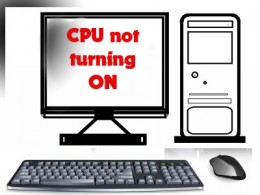
Problem: CPU Is Overheating
Solution: Don’t assume that high temps automatically warrant a new heatsink. The cooler is likely dusty clogged (try cleaning it), or the fan is dying (requiring a replacement). Or the heatsink has been poorly installed — remove it and remount it with new thermal paste. (Incidentally, degraded thermal paste alone can be the culprit.
Solution: Don’t assume that high temps automatically warrant a new heatsink. The cooler is likely dusty clogged (try cleaning it), or the fan is dying (requiring a replacement). Or the heatsink has been poorly installed — remove it and remount it with new thermal paste. (Incidentally, degraded thermal paste alone can be the culprit.
Here are our picks for the best thermal paste ). Other possible causes include the case fans — clean and check them. Or a newer, hotter GPU could have swamped your case’s ability to stay cool.
A BIOS update could also change the fan profiles from what you had set. Also keep this in mind: If your CPU is seemingly running “hot” but the machine isn’t blue – screening or throttling clock speed, you probably don’t have to sweat it.
Problem: CPU Is Slow
Solution: CPU performance issues typically come from misconfiguration in the BIOS or overheating.
Solution: CPU performance issues typically come from misconfiguration in the BIOS or overheating.
First, verify your chip’s clock speed by running CPU-Z ( www.cpuid.com ) while running a CPU load in Cine bench 11.5 ( www.maxon.net ). If the clocks are correct (remember, chips don’t Turbo under heavy loads on all cores), compare your Cine bench 11.5 scores with others on the Internet.
The scores should be within a few percentage points of others. If the scores are close, the CPU is not “slow;” it’s something else in your system. If the scores don’t match, you may have a thermal issue. Check that your heatsink hasn’t come loose, reapply thermal paste, and clean the heatsink and fans. A BIOS update could also be needed, as well.
Problem: CPU Is Unstable
Solution: CPUs rarely “go bad ” They typically work or don’t work. Usually, it’s everything around them that breaks. If you’re over clocking, stop. Try to isolate CPU problems by running a CPU- intensive app such as Prime95 . If it blues screens, check thermal issues first (see “CPU Is Overheating).
Solution: CPUs rarely “go bad ” They typically work or don’t work. Usually, it’s everything around them that breaks. If you’re over clocking, stop. Try to isolate CPU problems by running a CPU- intensive app such as Prime95 . If it blues screens, check thermal issues first (see “CPU Is Overheating).
Also check your RAM with Memtest 86+ ( www.memtest.org). Check your power supply connectors to the mobo and GPU. If the PSU is overheating and failing, it could cause crashes. Failing PSUs cause power sags, which can look like a bad CPU, too. If you have a known good PSU you can swap in, do so. Oddly enough, a failing GPU can resemble a CPU failure, so if you have a spare GPU or an integrated option, try switching to it and testing again.
Problem: CPU Is Always Under a Heavy Load
Solution: Heavy CPU usage can be a sign of malware, so make sure your AV is updated and run a full system scan. Also consider running a secondary scan using Malware bytes Free ( www.malwarebytes.org ) and any of the free web-based scanners such as those from Trend Micro , Bit Defender , or ESET .
Solution: Heavy CPU usage can be a sign of malware, so make sure your AV is updated and run a full system scan. Also consider running a secondary scan using Malware bytes Free ( www.malwarebytes.org ) and any of the free web-based scanners such as those from Trend Micro , Bit Defender , or ESET .
Also check to see that your own AV app isn’t thrashing the system by doing a scans check the running processes in Task Manager (Ctrl + Alt + Del, Start Task Manager, select Processes.) Click the CPU column to sort by usage and begin searching the Internet for each suspicious process name.
Problem: CPU Only Works in Single -Channel Mode
Solution: First, make sure the RAM is OK by running Memtest 86+ (www.memtest.org ). If the RAM clears, check the slots for debris and swap out the DIMMs for known good RAM. If crashing persists when put into dual – channel mode, you likely bent a pin installing your CPU.
Solution: First, make sure the RAM is OK by running Memtest 86+ (www.memtest.org ). If the RAM clears, check the slots for debris and swap out the DIMMs for known good RAM. If crashing persists when put into dual – channel mode, you likely bent a pin installing your CPU.
We’ve seen this on LGA1366 and LGA1155 platforms several times. It can be fixed by taking a sharp knife and carefully straightening the pin in the socket (or on the CPU in AMD chips).

Leave a Comment